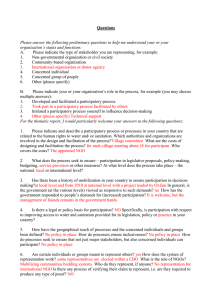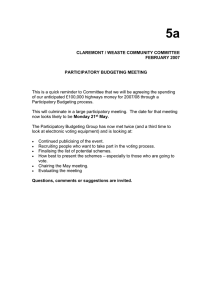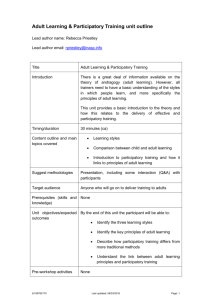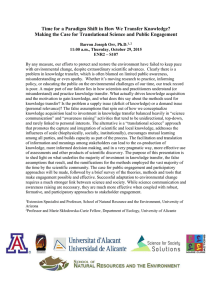Questions Please answer the following preliminary questions to help me understand... organization’s status and functions:
advertisement
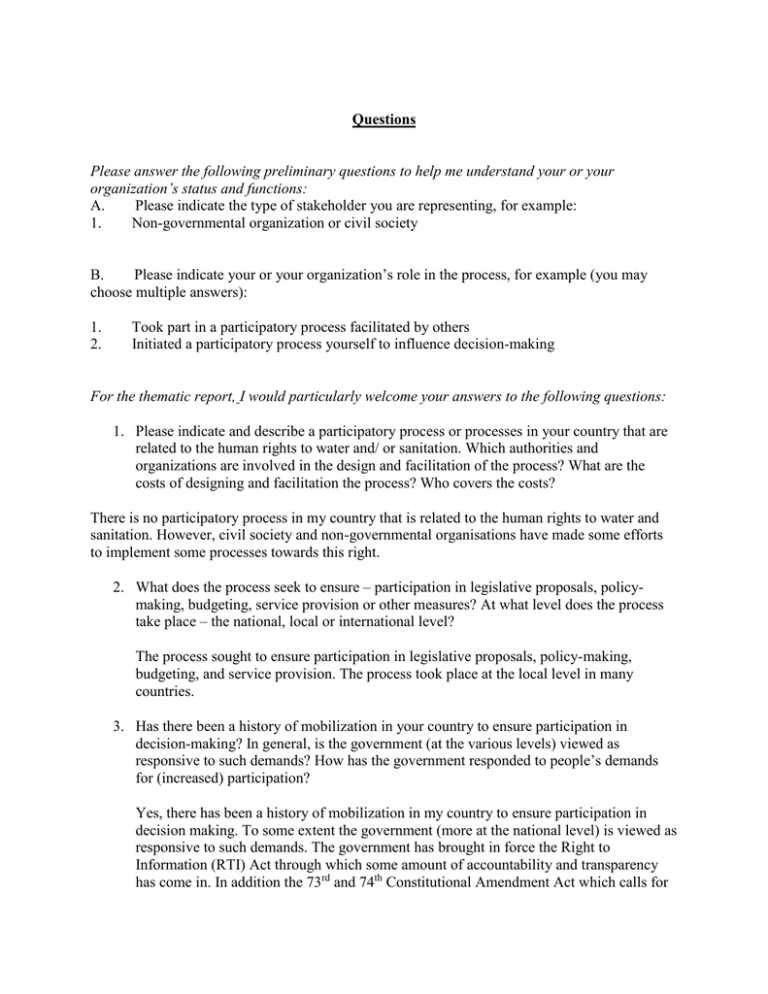
Questions Please answer the following preliminary questions to help me understand your or your organization’s status and functions: A. Please indicate the type of stakeholder you are representing, for example: 1. Non-governmental organization or civil society B. Please indicate your or your organization’s role in the process, for example (you may choose multiple answers): 1. 2. Took part in a participatory process facilitated by others Initiated a participatory process yourself to influence decision-making For the thematic report, I would particularly welcome your answers to the following questions: 1. Please indicate and describe a participatory process or processes in your country that are related to the human rights to water and/ or sanitation. Which authorities and organizations are involved in the design and facilitation of the process? What are the costs of designing and facilitation the process? Who covers the costs? There is no participatory process in my country that is related to the human rights to water and sanitation. However, civil society and non-governmental organisations have made some efforts to implement some processes towards this right. 2. What does the process seek to ensure – participation in legislative proposals, policymaking, budgeting, service provision or other measures? At what level does the process take place – the national, local or international level? The process sought to ensure participation in legislative proposals, policy-making, budgeting, and service provision. The process took place at the local level in many countries. 3. Has there been a history of mobilization in your country to ensure participation in decision-making? In general, is the government (at the various levels) viewed as responsive to such demands? How has the government responded to people’s demands for (increased) participation? Yes, there has been a history of mobilization in my country to ensure participation in decision making. To some extent the government (more at the national level) is viewed as responsive to such demands. The government has brought in force the Right to Information (RTI) Act through which some amount of accountability and transparency has come in. In addition the 73rd and 74th Constitutional Amendment Act which calls for the creation of rural and urban local bodies at the third tier of governance in an effort to ensure participation. 4. Is there a legal or policy basis for participation? Specifically, is participation with respect to improving access to water and sanitation provided for in legislation, policy or practice in your country? Excepting the RTI and the 73rd and 74th Constitutional Amendment Act, there is no legislation or practice with regard to improving access to water and sanitation (watsan) in my country. Since watsan is a State subject, respective states have a policy of participation in their specific City Development Plans (CDP) under the Jawaharlal Nehru National Urban Renewal Mission. Additionally, the National Urban Housing and Habitat Policy, 2007 and Urban Sanitation Policy only give out policy guidelines. 5. How have the geographical reach of processes and the concerned individuals and groups been defined? How do processes ensure inclusiveness? How do processes seek to ensure that not just major stakeholders, but also concerned individuals can participate? The geographical reach of processes and the concerned individuals and groups have been defined on the basis of the respective State programmes for watsan and at the national level, the Centrally Sponsored Schemes like Jawaharlal Nehru National Urban Renewal Mission, National Rural Drinking Water Programme and Nirmal Bharat Abhiyan. These schemes do have a component of inclusion in them. Through these components of inclusion, concerned individuals can participate. 6. Are certain individuals or groups meant to represent others? How does the system of representation work? What is the role of NGOs? Who do they represent, if anyone? Is there any process of verifying their claim to represent, i.e. are they required to produce any type of proof? Yes. The system of representation works through the urban and rural local bodies. NGO’s usually play the role of facilitators and motivators. They mostly represent the community but in some cases they also represent the private entities who are in the community as service delivery agents. There is no process of verifying their claim to represent. 7. What are the opportunities for participation? Are there consultations, hearings, opportunities to submit written responses and online fora? The opportunities for participation are usually consultations and hearings. 8. What measures are in place to enable people to participate? What measures are taken to overcome barriers that people face, in particular marginalized groups and individuals? There are no visible measures in place for people to participate. 9. What channels have been used to disseminate information about the envisaged measures and the participatory process? Through media information is disseminated about the envisaged measures and the participatory process. 10. How are the inputs taken into account? What is the impact of participatory processes on decision-making and the design of measures and policies? The inputs are taken through the participatory processes inbuilt in the schemes. However, there is not much impact of these processes on decision making and the design of measures and policies 11. What follow-up has been put in place? Are people informed about the outcome of processes? Are they informed about whether and how their proposals have been taken into account? There has been no follow-up put in place. People are neither informed about the outcome of processes nor on how the proposals have been taken into account. 12. Would you describe the participatory processes as successful? If the specific process referred to above has been completed, please comment on what accounts for its success or failure. Has the process been evaluated? What lessons does it offer for future processes? The participatory processes have not been successful.
